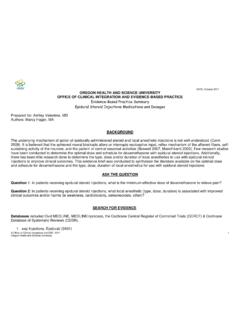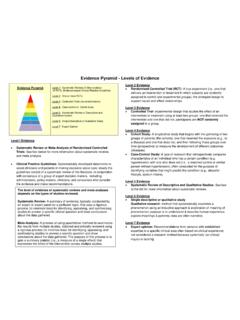Transcription of The Hierarchy of Evidence Pyramid
1 The Hierarchy of Evidence Pyramid Available from: [accessed 12 Dec, 2019] Available from: [accessed 14 March 2020] CLINICAL ORTHOPAEDICS AND RELATED RESEARCH Number 413, pp. 19 24 2003 Lippincott Williams & Wilkins, Inc. Hierarchy of Evidence : From Case Reports to randomized Controlled Trials Brian Brighton, MD*; Mohit Bhandari, MD, MSc**; Paul Tornetta, III, MD ; and David T. Felson, MD* In the Hierarchy of research designs, the results of randomized controlled trials are considered the highest level of Evidence . Randomization is the only method for controlling for known and unknown prognostic factors between two com- parison groups. Lack of randomization predis- poses a study to potentially important imbal- ances in baseline characteristics between two study groups.
2 There is a Hierarchy of Evidence , with randomized controlled trials at the top, con- trolled observational studies in the middle, and uncontrolled studies and opinion at the bottom. From the *Boston University School of Medicine and School of Public Health, Boston University, Boston, MA; the **Department of Clinical Epidemiology and Biosta- tistics, McMaster University, Hamilton, Ontario, Canada; and the Department of Orthopaedic Surgery, Boston Uni- versity, Boston, MA. Reprint requests to Mohit Bhandari, MD, McMaster Uni- versity Health Sciences Center, Department of Clinical Epidemiology and Biostatistics, Health Science Centre, Room 2C3, 1200 Main Street West, Hamilton, Ontario, L8N 3Z5 Canada.
3 Phone: 905 525-9140 ext. 22825; Fax: 905 524-3841; E-mail: DOI: This Hierarchy has not been supported in two re- cent publications in the New England Journal of Medicine which identified nonsignificant differ- ences in results between randomized , controlled trials, and observational studies. The current au- thors provide an approach to organizing pub- lished research on the basis of study design, a hi- erarchy of Evidence , a set of principles and tools that help clinicians distinguish ignorance of evi- dence from real scientific uncertainty, distin- guish Evidence from unsubstantiated opinions, and ultimately provide better patient care. In the Hierarchy of research designs, the results of randomized controlled trials are considered the highest level of Randomization is the only method for controlling for known and unknown prognostic factors between two comparison , 26 Lack of randomization predisposes a study to potentially important imbalances in baseline characteristics between two study groups.
4 The role of nonrandomized (observational) studies in evaluating treat- ments is an area of continued debate: deliber- ate choice of the treatment for each patient 19 Downloaded from by BhDMf5ePHKav1zEoum1tQfN4a+kJLhEZgbsIHo4 XMi0hCywCX1 AWnYQp/IlQrHD3oaxD/vH2r74b7+NAL/T0XV2hVa 0sPFhqAJ/HU+hxuW0= on 03/19/2020 Clinical Orthopaedics 20 Brighton et al and Related Research implies that observed outcomes may be caused by differences among people being given the two treatments, rather than the treatments alone. Unrecognized confounding factors can interfere with attempts to correct for identified differences between groups. There has been considerable debate about whether the results of nonrandomized studies are consistent with the results of randomized controlled , 10, 12 14, 21, 22, 28 Nonrandomized studies, or obser- vational studies, have been reported to overes- timate or underestimate treatment , 22 These considerations have supported a hi- erarchy of Evidence , with randomized con- trolled trials at the top, controlled observa- tional studies in the middle, and uncontrolled studies and opinion at the bottom.
5 However, these findings have not been supported in two recent publications in the New England Jour- nal of Medicine that identified nonsignificant differences in results between randomized , controlled trials and observational , 13 The current authors provide an approach to organizing published research on the basis of study design, a Hierarchy of Evidence . The key features and the advantages and disadvantages of specific study designs will be addressed. The concepts presented hopefully will enable clinicians and healthcare personnel to practice in the context of Evidence -based orthopaedics. Types of Study Design The types of study designs used in clinical re- search can be classified broadly according to whether the study focuses on describing the distributions or characteristics of a disease or elucidating its determinants.
6 Descriptive studies are concerned with de- scribing the general characteristics of the dis- tribution of a disease, particularly in relation to person, place, and time. Cross-sectional studies, case reports, and case series represent types of descriptive studies. Information on each can provide clues leading to the genera- tion of a hypothesis that is consistent with ex- isting knowledge of disease occurrence. Analytic studies focus on determinants of a disease by testing a hypothesis with the ulti- mate goal of judging whether a particular ex- posure causes or prevents disease. Analytic design strategies include observational stud- ies, such as case-control and cohort studies, and clinical trials.
7 The difference between the two types of analytic studies is the role that the investigator plays in each of the In the observational study, the investigator sim- ply observes the natural course of events. In the randomized controlled trial, the investiga- tor assigns the intervention or treatment. Al- though an in-depth discussion on assessing the methodologic quality of each particular study is beyond the scope of the current study, the basic strengths and limitations of each re- search strategy will be addressed. Levels of Evidence Investigators have attempted to minimize po- tentially harming patients by basing clinical decisions of the sorts of Evidence that are least likely to be wrong.
8 Two studies defined what was thought to be the Evidence provid- ing the least biased estimate of the effect of an intervention: a systematic review document- ing homogeneity in results of a large number of high-quality randomized controlled trials ( randomized with concealment, blinded, com- plete followup, and intention-to-treat analy- sis).8,25 This was termed Level 1 Evidence . These investigators additionally categorized studies of an intervention based on an increas- ing degree of potential bias: systematic re- views with randomized controlled trials that reveal differences in treatment effect (hetero- geneity); individual high-quality randomized controlled trials (Level IB Evidence ); less rig- orous randomized controlled trials; cohort or observational studies (Level 2 Evidence ); case-control studies (Level 3 Evidence ); case series (Level 4 Evidence ), and expert opinion (Level 5 Evidence ).
9 23 Based on the various levels of Evidence of a particular treatment, grades of recommendation can be deter- ,26 For example, the following grades of recommendations have been proposed: (1) Grade A, consistent Level 1 studies; (2) Grade B, consistent Level 2 or Level 3 studies; (3) Number 413 August, 2003 Hierarchy of Evidence 21 Grade C, Level 4 studies; and (4) Grade D, Level 5 ,26 Case Report and Case Series Case reports are an uncontrolled, descriptive study design involving an intervention and out- come with a detailed profile of one patient. An early example from the orthopaedic literature of a case report is Birkett s 1869 description of a fracture-dislocation of the Expansion of the individual case report to include multiple patients with an outcome of interest is a case series.
10 In 1981, a famous case series involving five homosexual men in Los Angeles, CA with Pneumocystis carinii between 1980 and 1981 marked the beginning of the AIDS epidemic in the United Although descriptive stud- ies are limited in their design to make causal in- ferences about the relationship between risk factors and an outcome of interest, they are helpful in developing a hypothesis that can be tested using an analytic study design. Case-Control Study One type of observational study is the case- control study that starts with the identification of individuals who already have the outcome of interest, cases, and are compared with a suit- able control group without the outcome event. The relationship between a particular interven- tion or prognostic factor and the outcome of in- terest is examined by comparing the number of individuals with each intervention or prognos- tic factor in the cases and controls.





